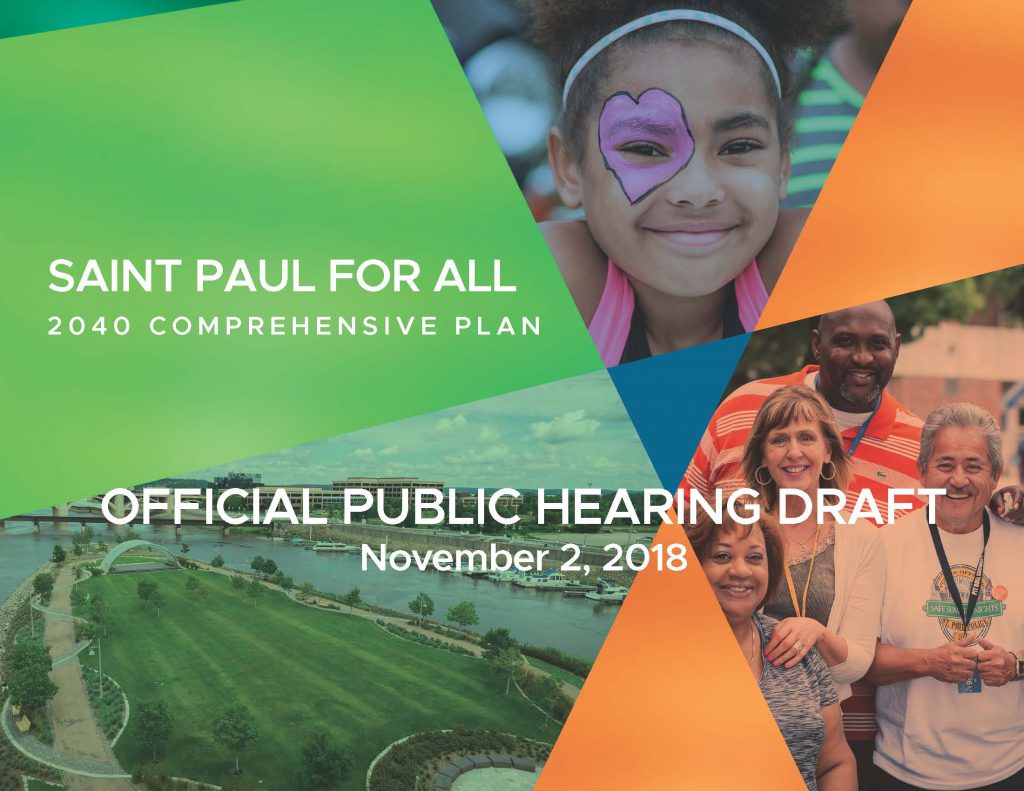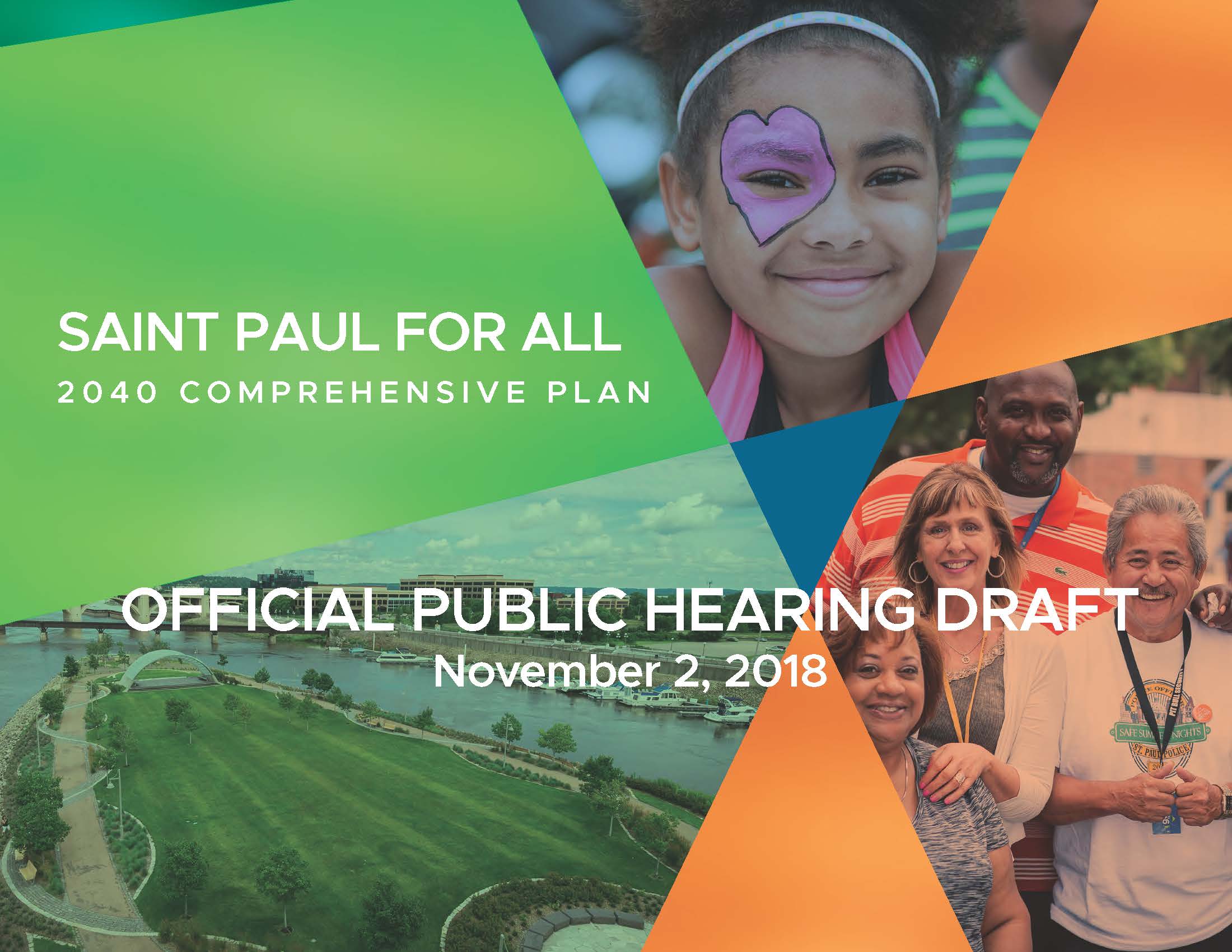Saint Paul for All: It’s Time to Envision Our Future
by Jerry Rothstein
Our regional, county and city governments are challenging us as citizens in many ways to become engaged in a creative effort of imagining what kind of community we want to have in the decades ahead.

The Metropolitan Council’s Thrive MSP 2040 addresses issues that transcend any one neighborhood, city, or county, including transportation, jobs, community development, affordable housing.
Municipalities work on their elements of the regional plan, and must have a Comprehensive Plan with a 20-year time frame, updated every 10 years consistent with the Metropolitan Council’s regional plan (Thrive MSP 2040) and regional policy plans for transportation, parks, housing and water.
Saint Paul for All, the St. Paul 2040 Comprehensive Plan, is divided into six main chapters, each focusing on a specific topic area: they cover land use; transportation; parks, recreation and open space; housing; water resources management; and heritage and cultural preservation. An additional chapter covers the Mississippi River Corridor Critical Area. The draft document is available at the West 7th Library, and on line at stpaul.gov/departments/planning-economic-development/planning/2040-comprehensive-plan.
Interrelated sets of core values, community priorities, and the city’s current focus areas provide guidance and focus for the development of each chapter.
For example, consideration of these focus areas is integrated into each chapter:
• Racial and social equity, and diversity.
• Aging in the community.
• Community and public health.
• Economic development.
• Sustainability and resilience.
• Urban design.
At the same time, the identification of significant challenges and opportunities also informs each chapter:
• Equity (again) demands that we reduce racial disparities in jobs, income, housing cost burden, education and home ownership, as well as disparities in the justice system and the effects of structural prejudice.
• Growth and density issues.
• Economic development.
• Large redevelopment sites now in process or to become available.
• Climate change mitigation, adaptation and resiliency — readying ourselves for the unpredictable but inevitable consequences of climate change.
• Designing for all ages and abilities.
• Fostering the next generations.
• New technologies and their impact on development patterns.
Each chapter represents a combination of information from present practices; research; existing initiatives such as the City Council’s resolution on affordable housing now made very real by Mayor Carter’s proposed $71 million investment in the 2019 budget; responses to major trends both globally and locally. Climate change is a global issue with local consequences. Our aging housing stock and infrastructure is a local phenomenon with direct effects on many identified goals in the area of affordable housing, as well as financing, equity, growth and density among others.
The Concept of Neighborhood Nodes
In this vast and complex document, there are many ideas that push our boundaries and ask us to think seriously about community visions that might be different from what we are used to now. This is, after all, a plan for the future. The Neighborhood Nodes idea refers to “compact, mixed use areas that provide shops, services, neighborhood-scale civic and institutional uses, recreational facilities and employment close to residences. They may be neighborhood centers, transit station areas or urban villages, and have often developed adjacent to major intersections or at former street car stops.
“Neighborhood Nodes serve a neighborhood’s daily needs, including access to food; reduce public infrastructure disparities; improve livability; and accommodate growth. The intent is for Neighborhood Nodes to be denser concentrations of development relative to the adjacent future land use categories. Neighborhood Nodes foster an equitable system of compact, mixed-use and commercial centers across the city to increase access to community services (such as health care) and businesses, and support pedestrian-oriented neighborhoods.
“Investment in Neighborhood Nodes will tap the economic, cultural and human assets of Saint Paul’s diverse neighborhoods, and can foster micro-economies that celebrate those assets.”
In the west End, these areas have been identified as potential Neighborhood Nodes:
• Grand-W. 7th /Seven Corners
• Montreal-W. 7th/Lexington
• Randolph-W. 7th /Schmidt
• Shepard-Davern/Sibley Manor
• St. Clair-W. 7th
• Victoria Park
Policies that further the development of Nodes include increasing density toward the center of the node and transition in scale to surrounding land uses; prioritizing pedestrian-friendly urban design and infrastructure that emphasizes pedestrian safety; clustering neighborhood amenities to create a vibrant critical mass; and improving access to jobs by prioritizing development with high job density. Analysis of historical patterns also supported the idea that there would be a Neighborhood Node within 20-minute (or less) walk of any residence in St. Paul.
Saint Paul for All is a blueprint with significant outcomes. It will guide zoning decisions; expenditures; private investment and direct attention to securing other sources of funds. It will also stand for the city’s vision and core values of equity and opportunity for all; resiliency and sustainability; innovation and creativity; welcoming and safe.
After the January 11 Planning Commission public hearing, City Council will hold a public hearing for the entire draft plan in June 2019 and adopt the plan in that month.
Community Engagement Opportunities
Public Hearing: Draft 2040 St. Paul Comprehensive Plan
Jan 11, 8:30 a.m. City Hall Room 40
The draft 2040 Comprehensive Plan and an opportunity to submit formal public comments can be found at stpaul.gov/SaintPaul4All. Formal public comments may be provided in one of three ways.
• Spoken testimony at the January 11 Planning Commission hearing.
• Online comment form at www.stpaul.gov/SaintPaul4All. Please include your full name and mailing address for comments to be included in the official public record.
• Mail comments to: Saint Paul Planning Commission c/o Lucy Thompson, 25 West 4th Street, Suite 1300, Saint Paul, MN 55102.
Dialogue/Presentation: Fort Road Federation/West 7th Business Association Task Force January 30, 6:30-8:30 p.m. Palace Community Center
Question: “What does an improved West Seventh Mean to You?”
Presentation and dialogue on the nine operating principles identified by the Task Force.


